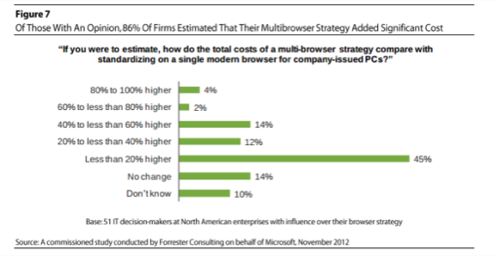
A Microsoft-funded study by Forrester to be released on Thursday claims that enterprises face significant costs for supporting more than one browser among their employees.
The study, which ReadWrite viewed in advance, found that supporting an “alternative” browser carries extra costs when it comes to Web apps. The key metric of the study: $4,200. That’s the average amount the 133 companies polled told Forrester that they would be forced to spend per Web app per browser.
Enterprises Support Lots Of Web Apps
Forrester’s research also found that enterprise companies with 1,000 or more employees typically supported 92 Web applications, and medium-sized companies with 250-999 workers supported 28 Web apps. All told, Forrester found, companies could spend $118,000 to almost $400,000 on browser support alone, not counting additional support or staffing costs. 86% of the firms Forrester surveyed found that their IT costs increased significantly – about 20% – when they had to support multiple browsers.
Security ($1,000 per app) testing ($1,000) and training ($900) represented the top three cost buckets, and the companies told Forrester they actually feared break/fix support costs more than app compatibility. A proper, standards-compliant Web app should mitigate compatibility concerns, Forrester noted. But Roger Capriotti, director of marketing for Internet Explorer, argued that IT managers still can’t get away from the costs of testing, deployment and support, no matter how modern the alternative browser.

Microsoft’s Message
Not surprisingly, the message favors Microsoft. Alternative browsers typically mean ones not shipped with the PC – and Windows PCs come with Microsoft’s Internet Explorer.
Still, it’s no secret that complexity comes with cost and that simplicity is a common theme within IT departments these days. “I think cost is #1 in terms of this,” said Capriotti. “IT departments are getting squeezed, and things like total cost of ownership are becoming paramount.”
Forrester cast its survey in the light of the many companies standardized on Windows XP, who now plan a desktop “modernization” effort over the next 12 to 18 months. If they plan to stay with Windows, those companies face a choice: jump to IE10 on Windows 7, or make the leap all the way to Windows 8, which also uses IE10. In that context, it’s no wonder security was the primary reason for their upgrade, as Microsoft has launched campaigns to try and eliminate the notoriously insecure IE6, the browser that originally shipped with Windows XP.
The question of which browser is leading the desktop PC market remains open; StatCounter puts IE’s November share at 31.2%, behind Google’s Chrome, at 35.7%. But NetApplications, whose numbers Microsoft has favored, claims IE held 54.8% of the market in November, with Chrome at 17.24% and Firefox at 20.44%.)

A bare majority – 51% – of the 133 enterprises surveyed by Forrester not only require a single browser, but enforce it, either by removing administrative rights or otherwise locking down the PC. Another 45% allow users to install alternative browsers, but either don’t support them (13%) or simply support them on a best-effort basis (32%).
What The Survey Didn’t Ask
Unfortunately, Forrester didn’t survey those businesses on the costs of moving from XP to Windows 7 – or, for those businesses already on Windows 7, from IE9 to IE10. According to Capriotti, however, the broader support for Web standards within IE10 justify any transitional costs. The survey also didn’t address any benefits the companies might gain by supporting multiple browsers.
A few years ago, the operating system was the primary area of concern for enterprises. But with more corporate applications migrating to the Web, app compatbility is becoming more important. Does this let Microsoft keep some of the same advantages it enjoyed by controlling the Windows platform? Forrester, funded by Microsoft’s dime, says yes.

















